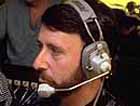October 25, 2004
The Voice in the Ear
Coming back from the TCT
meeting in Washington,
I've been reflecting on this whole field of interventional cardiology
and how much it's changed since I first got involved in it over 25
years ago. As co-editor of Angioplasty.Org,
I write articles and oversee much of the content that appears on
the site, but some of
my more personal observations don't really fit into the structure
of a "feature topic", so I've decided (oh, Lord!) to start
a so-called
"blog" to talk about issues in the medical device industry
and health information on the Internet that I feel strongly about.
For better
or worse, here it is. I'm calling it "The Voice in the Ear" --
referencing my many years as a TV director of live medical demonstration
courses, such
as the ones viewed at meetings like the TCT.
At the risk of becoming
too "topical" (I'm referring here, of course, to the
so-called controversy about whether George Bush had a wired earpiece
during
the 2004 debates)  I
readily admit that I was, in fact, the "voice in the ear" for
many interventional cardiologists during the scores of procedures
that
I broadcast to professional audiences in the first two decades
of coronary angioplasty. Our mission was
to teach other cardiologists how to do procedures.
And when you're in "live broadcast" mode, you must have
a means of communicating with the operating physician. So the cardiologist
had
a wireless earpiece, called an IFB (internal feedback) in his ear,
and I could communicate directly (and privately) with him while
he was operating on a
patient.
Obviously, I used this power judiciously, but it was usually to
convey such important information as "the next case isn't
ready yet, so stretch your discussion to fill time" or "it's
getting late and the audience needs to go to lunch, so wrap it
up" or "can
you tilt the pressure gauge slightly to your right, so the camera
can see how
many atmospheres the balloon is being inflated to?" I
readily admit that I was, in fact, the "voice in the ear" for
many interventional cardiologists during the scores of procedures
that
I broadcast to professional audiences in the first two decades
of coronary angioplasty. Our mission was
to teach other cardiologists how to do procedures.
And when you're in "live broadcast" mode, you must have
a means of communicating with the operating physician. So the cardiologist
had
a wireless earpiece, called an IFB (internal feedback) in his ear,
and I could communicate directly (and privately) with him while
he was operating on a
patient.
Obviously, I used this power judiciously, but it was usually to
convey such important information as "the next case isn't
ready yet, so stretch your discussion to fill time" or "it's
getting late and the audience needs to go to lunch, so wrap it
up" or "can
you tilt the pressure gauge slightly to your right, so the camera
can see how
many atmospheres the balloon is being inflated to?"
In any case, I was the
voice in the ear to many of the pioneering interventional cardiologists,
so I thought it would be a fitting title for my ramblings....
|
